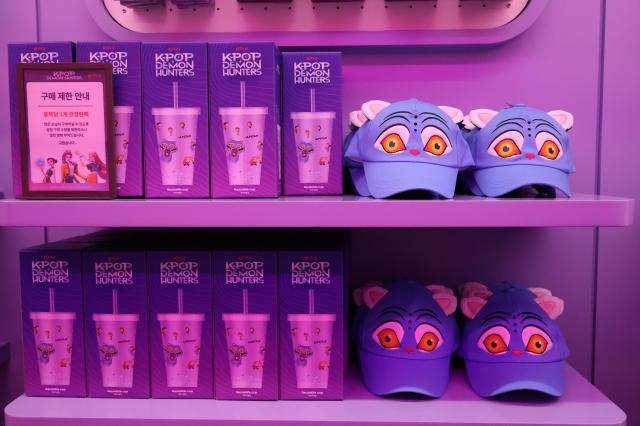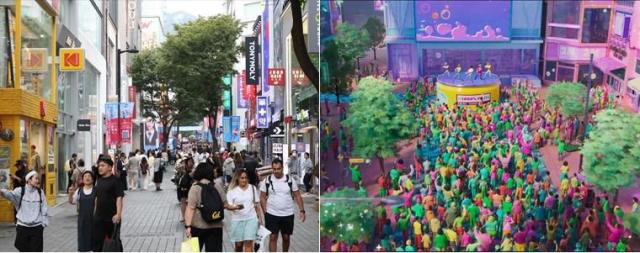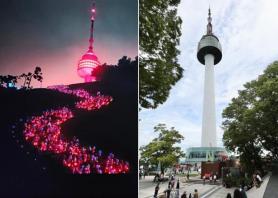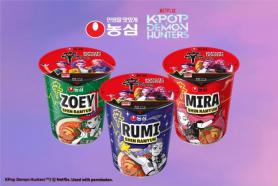
Right: A family poses for a photo at the "KPop Demon Hunters" zone at Everland, Korea's largest theme park in Yongin, Gyeonggi Province, on Oct. 1, 2025. AJP Yoo Na-hyun
The iconic headgear – spotlighted in Saja Boys' "Your Idol" stage performance that won global fans and in Netflix's blockbuster "KPop Demon Hunters" – is now a must-try at Everland, Korea's largest theme park in Yongin, just south of Seoul.
"I've watched the film twice," said Austin, 48, who visited Korea with his family of fellow fans. "My younger daughter has watched it too many times to count. My older daughter has seen it four times. It was number one in New Zealand for several days."
The "KPop Demon Hunters" zone, created in collaboration with Netflix, drew more than 10,000 visitors in its first week. Children and adults alike dress up as Huntrix or Saja Boys, pose for photos, and dance to soundtrack hits such as "Golden" and "Soda Pop" in a concert-like atmosphere. Themed goods fly off the shelves, with the "gat" topping the list as a Halloween souvenir.

Signature snacks from the film – Saja Boys' soda pop ade, Huntrix's golden glow ade, or Derpy the tiger's berry world – add to the fun. The Huntrix Set at the snack bar has become the runaway favorite.

Right: A scene from Netflix's animated film "KPop Demon Hunters." Courtesy of Netflix / Graphics by AJP Song Ji-yoon
Beyond fantasy, "KPop Demon Hunters" has introduced foreign fans to authentic Korean rituals. One of the film's most moving scenes unfolds in a public bathhouse, a space where Koreans traditionally relax, chat, and spend intimate time with family or friends. Visitors eager for the "real" experience often try "sesin," a vigorous body scrubbing and massage service featured in the movie.

Another must-stop is a traditional medicine clinic. In the film, Huntrix leader Rumi seeks treatment there after losing her voice during rehearsal. Tourists also line up to try acupuncture or shop for herbal remedies.
"I like all Eastern medicine. I think it’s quite interesting," said Jacob Raffly, a 33-year-old American visiting Seoul K-Medi Center with his wife Raina. "I'm half-Korean, so we thought it would be nice to see this side of Korea," Raina added.

The cultural pull doesn't end there. The National Museum of Korea in Yongsan – once seen as austere – is now bustling with foreign families and friends, rediscovering ancient relics through the film’s fusion of history and modern storytelling.
"I was never into K-pop, but I’ve been fascinated by the culture," said Evan Stauv from France.
The museum has seen visitors surge 77.5 percent to 4.33 million as of August, on track to hit 5 million this year. Foreign visitors alone reached nearly 150,000, with July and August numbers spiking after the film's release. Sales at the museum store climbed 34 percent to 11.5 billion won ($8.2 million) and are expected to surpass 20 billion won for the first time.

The shopping and food mecca of Myeong-dong remains a perennial favorite for those wanting a taste of today’s Korea. "K-pop was part of the reason," said Lila Destras from France, "but personally I wanted to discover the country as a whole."
For many, visiting Korea has shifted from sightseeing to living the culture – stepping into its past while embracing its modern pulse.
Copyright ⓒ Aju Press All rights reserved.


